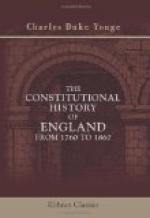[Footnote 52: Lord Stanhope, however, has reason on his side when he calls the words of this petition “vague and general,” though “kindly and respectful;” and when he points to the language of extreme bitterness against England indulged in by Franklin at the very time that this petition was voted. He, however, expresses a belief that even then “the progress of civil war might have been arrested,” which seems doubtful. But it is impossible not to agree with his lordship in condemning the refusal by the ministry to take any notice of the petition, on the ground that the Congress was a self-constituted body, with no claim to authority or recognition, and one which had already sanctioned the taking up arms against the King.—History of England, vi., 93, 95, 105.]
[Footnote 53: It is probable, however, that the greater part of the Hanoverian soldiers were Protestants.]
[Footnote 54: Lord Campbell, who, in his “Life of Lord Bathurst,” asserts that the legality of the measure turns upon the just construction of the Act of Settlement, adduces Thurlow’s language on this subject as “a proof that he considered that he had the privilege which has been practised by other Attorney-generals and Chancellors too, in debate, of laying down for law what best suited his purpose at the moment.” It does not seem quite certain that the noble and learned biographer has not more than once in these biographies allowed himself a similar license in the description of questions of party politics.]
[Footnote 55: In the debates on the subject it was stated that the number of Hanoverians quartered in the two fortresses was nineteen hundred, and the number of British troops left in them was two thousand. Moreover, as has been already remarked, though Lord Shelburne spoke of arming Roman Catholics, it is probable that the Hanoverians were mostly Protestants.]
[Footnote 56: The Preliminary or Provisional Articles, as they were called, of which the Definitive Treaty was but a copy, were signed at Paris, November 30, 1782, during Lord Shelburne’s administration. But the Definitive Treaty was not signed till the 3d of September of the following year, under the Coalition Ministry, which was turned out a few weeks afterward.]
[Footnote 57: We shall see in a subsequent chapter that even in this reign of George III. Pitt laid down the true principles of our legislation for the colonies in his bill for the better government of Canada.]
[Footnote 58: An admirably reasoned passage on the influence of the crown, especially in the reigns of the two first Hanoverian Kings, will be found in Hallam, “Constitutional History,” c. xvi., vol. iii., p. 392, ed. 1832.]
[Footnote 59: The “Parliamentary History” shows that he had brought forward the same motion before 1780; since Lord Nugent, who replied to him, said “the same motion had been made for some years past, and had been silently decided on.” From which it seems that it was never discussed at any length till May 8, 1780.]




